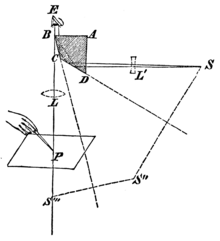Camera lucida
The British chemist and physicist William Hyde Wollaston registered a patent for a drawing instrument under the name Camera Lucida in 1806 , the principle of which had long been known. Ua already seems Johannes Kepler to have known such a device. The camera lucida served a similar purpose as the camera obscura and was used to depict landscapes or portraits. In biological research, camera lucida projections of microscopic specimens were used as a template.
functionality
"The Camera Lucida is a square prism that is mounted on a bracket for outdoor use and attached to the drawing pad [...] or attached to the eyepiece of a telescope or microscope."
With the camera lucida , one looks through a peephole directly over the edge of the prism, which throws the outlines of the motif onto the drawing paper . The user can see the outlines of the motif and the paper at the same time and can then simply draw the object. The camera lucida makes it easier to take relatively lifelike pictures.
history
William Henry Fox Talbot (1800–1877), who was dissatisfied with his talent for drawing, had looked for a tool to make sketches on Lake Como in 1833 and therefore further developed the projection devices based on the camera obscura , which were already used by Robert Hooke in 1679 ( 1635–1703) had been constructed.
In the course of the 19th and 20th centuries, the camera lucida developed into an important tool in entomology for precisely drawing the wing veins of insects.
Related devices
The Physionotrace from 1786 is a mechanical aid for engraving silhouettes.
Individual evidence
- ↑ Erna Fiorentini: Instrument of judgment. Drawing with the Camera Lucida as a composite, 2005, S, 1 2 [1] (PDF; 923 kB).
- ↑ Erna Fiorentini: Instrument of judgment. Drawing with the Camera Lucida as a composite, 2005, p. 2 [2] (PDF; 923 kB).
literature
- Beaumont Newhall : History of Photography . 327 pages. Schirmer / Mosel 1998. ISBN 3-88814-319-5
- Wilfried Wiegand (editor): The truth of photography. Classic confessions to a new art . 304 pages. S. Fischer: Frankfurt am Main 1986. ISBN 3-10-091504-6
- Bodo von Dewitz & Werner Nekes (eds.): I see something that you don't see - viewing machines and worlds of images . Steidl, Göttingen 2002. ISBN 3-88243-856-8

